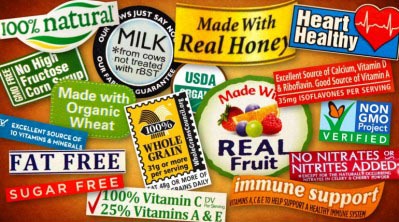
Read Food Labels Like a Pro: What You Need to Know
March 02, 2016 by 4P Foods
When you enter the grocery store, you are bombarded with labels on everything. From all-natural to Non-GMO verified and Fair Trade, it's confusing to keep everything straight and understand what's regulated and what's not. If something is labeled organic, what does that truly mean? It's important to understand the language of the grocery store in order to make better consumer choices. We've broken down the terms for you so you can make better choices:
Produce
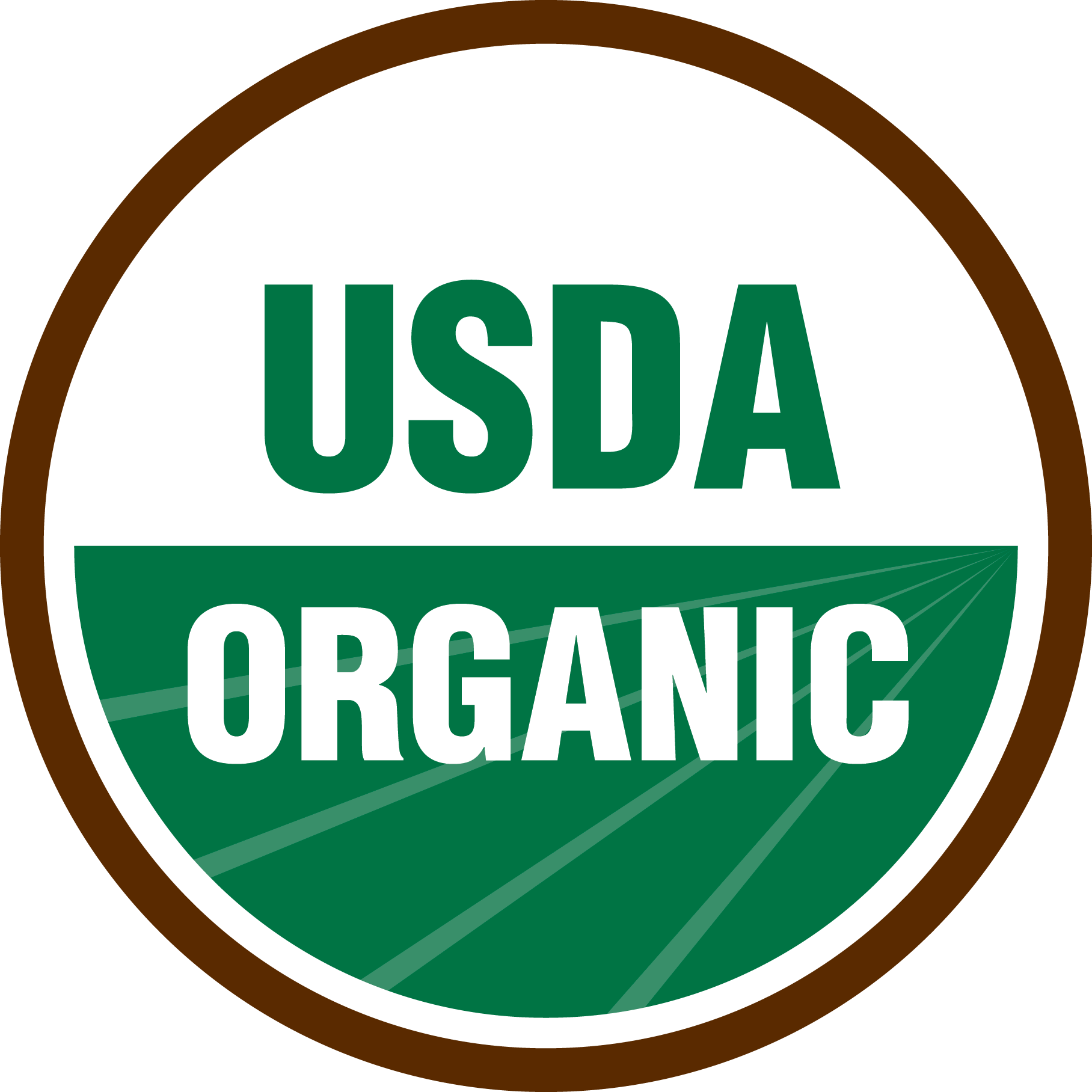
Certified Organic
Producers must follow a stringent set of rules to be considered USDA Organic: They can't use any synthetic pesticides, chemical fertilizers or GMOs. Contrary to popular belief, a USDA Organic label does not indicate that no pesticides are used. Pesticides derived from natural sources (like biological pesticides) may be used in producing organic food. Another misunderstanding is the use of synthetics in general. Some synthetic material can actually be used in organic foods, such as pheromones and animal vaccines. Additionally, a farm cannot have had any of the prohibited substances used on its land for three years prior in order to qualify for USDA Organic status.
Regulations prohibit organically processed foods from containing artificial preservatives, colors, or flavors and require that their ingredients are organic, with some minor exceptions. For example, processed organic foods may contain some approved non-agricultural ingredients, like enzymes in yogurt, pectin in fruit jams, or baking soda in baked goods.
Takeaway: Organic produce is definitely a better alternative to conventionally grown produce, but can still be far from perfect, especially if produced on extremely large "factory" farms. Even though organic farming doesn't use synthetic pesticides, chemical fertilizers or GMOs, organic farming is often done by huge agricultural corporations that also operate conventional farms. They don't necessarily care about restoring soil health, paying their workers a fair wage (many of the workers are undocumented or migrant labor who lack fair representation) or producing the most delicious fruits and vegetables. The size, location, and philosophy of the farm owners matter just as much as the organic certification itself, if thinking about the food and food system holistically. Buying from us, the farmer's market or a traditional CSA is always the best option because you know the farmer and their practices.
Natural
There is no government regulation of the word "natural" for any food. Even though most food labels are highly regulated, the word "natural" remains undefined. The only guidance for what qualifies as natural is nothing artificial or synthetic.
When the FDA has addressed questions of "natural," it has relied on a more informal policy it issued in 1993. It allows use of the term "natural" when "nothing artificial or synthetic . . . has been included in, or has been added to, a food that would not normally be expected to be in the food."
With only this informal statement to work from, the FDA has taken little regulatory action about use of the word "natural," other than a handful of warning letters.
Takeaway: If something says "100% natural" you're better off reading the ingredients label for information, because the word "natural" has little true meaning to it.
Local
There is no legal definition of what makes a food "local." Some consider a 400-mile radius local. Whole Foods says 200 miles. We consider whether something is grown locally not by mileage, but how it moves through the food shed. What we mean by that is a farm that is 100 miles from here could be behind 3 mountain ranges and take twice as much driving to get to, while a farm that is 200 miles from here could be located right on Route 81 which leads straight to our warehouse. We consider local to be anything that comes from the Chesapeake Bay area - extending from Central Pennsylvania to most of Maryland and Virginia down to the Northern part of North Carolina. The exception to this is our citrus fruit, of course which comes from Uncle Matt's in Florida.
Takeaway: Buying from us is one of the best guarantees that your food comes from the local food system. Other great options for local food are traditional CSAs and shopping your local farmers market.
Healthy
Similar to the "natural" label, the term "healthy" on food items is vague. Under food regulations, the term “healthy” can only be applied to certain categories of food—particularly those low in fat, saturated fat, and cholesterol—and the food must contain a certain percentage of vitamins. However, this means it often excludes "healthy" foods such as avocados, salmon, and nuts that are high in "good" fats and are considered beneficial.
Takeaway: Just because something is or isn't labelled healthy doesn't make it nutritious or healthy for your diet. In regards to eating healthy food, it's best to stick to Michael Pollan's easy rule: "Eat food. Not too much. Mostly plants."
Fair Trade
There are some basic principles that all fair trade goods must abide by. The production of these foods—the most common being cocoa, coffee, bananas, tea, and sugar —must be free of forced labor or poor working conditions for laborers. The crops are raised through sustainable methods, and no genetically modified crops are allowed to be certified Fair Trade. And perhaps most importantly, participating in a fair trade production chain can result in huge benefits for farmers.
However, Fair Trade has come under fire multiple times for bad practices. For instance, if a producer network seeking fair trade certification contains dozens or even hundreds of farmers in a co-operative network, auditors allow for a "group certification" rather than inspecting every farm individually. This can let poor labor or ecological practices slip through the cracks. Additionally, reports have been mixed on how much of a relationship is really developed between producer and consumer in the fair trade model.
Takeaway: Fair Trade Certified usually means better working and environmental conditions for the crop, but it's not a perfect certification.
Non-GMO Project Verified/GMO Free
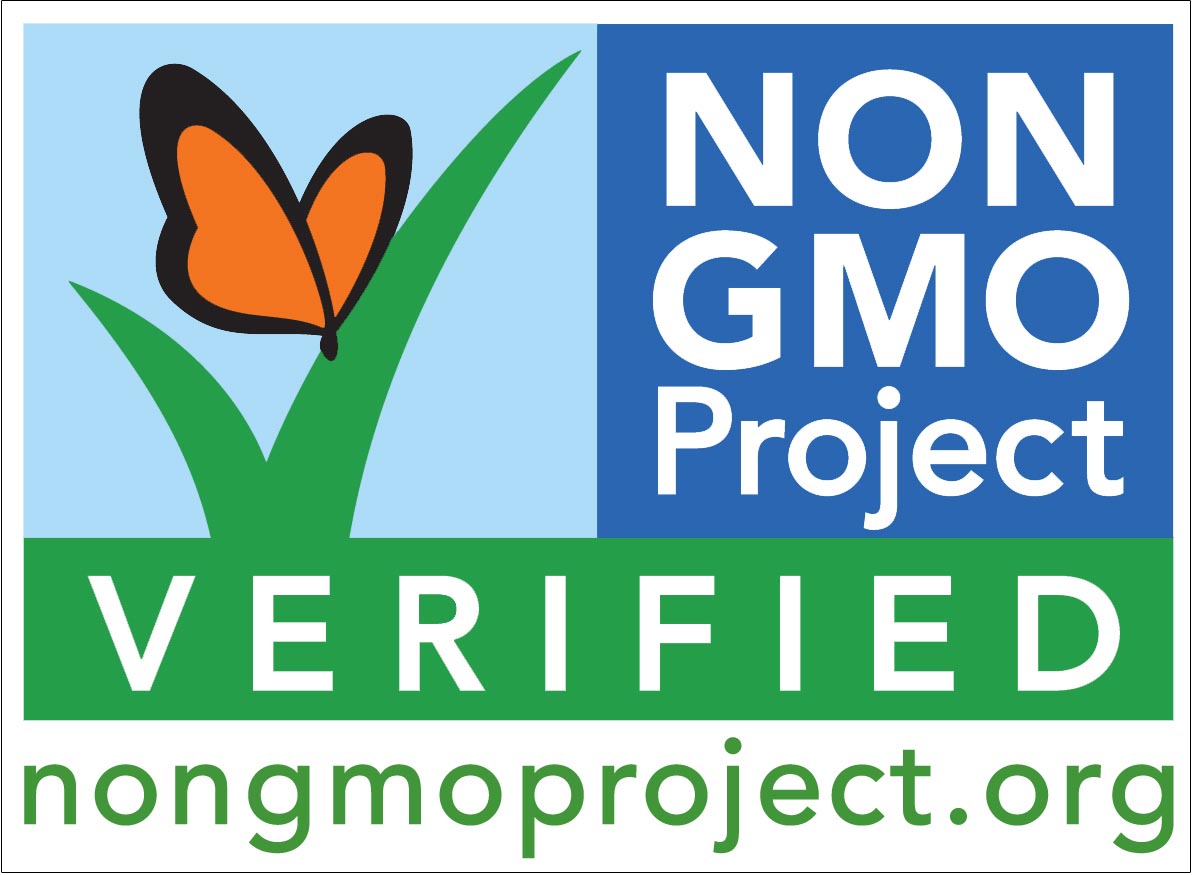
To understand this certification, it's important to first understand what GMOs are. Genetically modified organisms (GMOs) can be defined as organisms (i.e. plants, animals or microorganisms) in which the genetic material (DNA) has been altered in a way that does not occur naturally by mating and/or natural recombination.
Genetic modification a process that can be used in different ways to create different things. To think clearly about GMOs, you have to distinguish among the applications and focus on the substance of each case. If you’re concerned about pesticides and transparency, you need to know about the toxins to which your food has been exposed. A GMO label won’t tell you that.
How GMOs Are Made
Here’s how it works. Scientists take a plant. They change the plant by adding DNA from another plant, bacteria, or virus to it. DNA is what gives everything its special characteristics. So in this way, the original plant now has new qualities. The changes can make them more resistant to disease, bugs, or drought. It can give them other qualities too, like those that affect their taste or shelf life.
The Non-GMO Project is a non-profit organization committed to preserving and building the non-GMO food supply, educating consumers, and providing verified non-GMO choices. The only thing this label certifies is that the products were grown not using GMOs. This doesn't make them healthy, pesticide-free or natural; it simply means that they don't contain GMO ingredients.
Industry and health leaders cite hundreds of studies to support the safety of GMOs. That includes 20 years of studies in animals that have eaten modified food. However, much of the GMO food we eat comes from Monsanto's Roundup Ready crops, such as corn and soybeans. These crops are genetically modified to resist Roundup, an herbicide created by Monsanto, so the farmer can spray the whole field with the herbicide rather than targeting the invasive species themselves. This is highly problematic because it increases pesticide use and residue on the crops, as well as increasing pesticide runoff into the groundwater and the oceans. To add to that, an agency of the World Health Organization has classified the main chemical used in Roundup, glyphosate, as a “probable carcinogen.”
Monsanto, the maker of Roundup, disagrees and stands by the safety of its corn and GMO foods. The company is responsible for most of the world’s genetically modified crops. GMO seeds can't reproduce themselves, and farmers who use them must buy the seeds from Monsanto every time, creating a dependency system between Monsanto, Monsanto's pesticides and the farmer. GMOs are also responsible for creating "superbugs" and superweeds" that are becoming immune to pesticides such as Roundup, and posing a problem for all farmers. The way GMO technology currently exists, it lacks serious regulation and gives corporations such as Monsanto huge power and control over farming.
Takeaway: You can always be sure that any product certified organic is GMO free. GMOs are problematic for many reasons, and we support GMO labeling on products as well as more government regulation for how the technology is implemented. Not all GMOs are necessarily bad; it's used to create insulin for diabetics as well as many other pharmaceuticals. The technology itself is not problematic, but rather the way we use it in our current food system.
Eggs
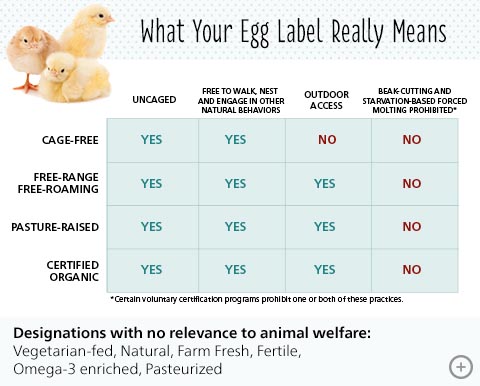
The best kinds of eggs come from farmers who let their chickens be outside, engage in natural behaviors, and eat bugs and worms. At 4P Foods we get our eggs from farms like Whiffletree Farm, who raise the hens on fresh pasture, with no GMO feeds, antibiotics, chemicals or vaccines.
Cage-Free
The hens don't live in cages. But they don't live in bucolic red barns, either. They usually live in aviaries: massive industrial barns that house thousands of birds. Each bird has, on average, 1 square foot of space. However, cage-free birds are better off than their caged counterparts. They're not exactly living on Old McDonald's farm, but they're able to walk around, perch, lay their eggs in a nest and spread their wings — all-important natural behaviors.
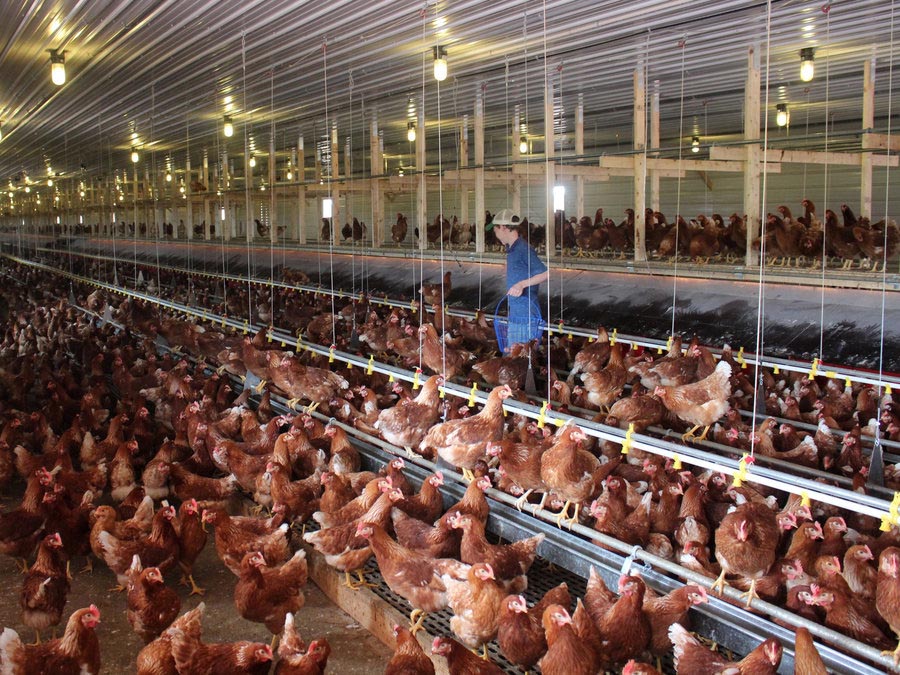
Janice Swanson, an animal scientist at Michigan State University, has been leading a three-year study of egg production techniques.
She says cage-free birds have more feathers and stronger bones and exhibit more natural behaviors. But crowded aviaries also come with risks: reduced air quality, and twice the likelihood of dying. Over the course of their three-year study, less than 5 percent of birds in cages died, compared with more than 11 percent of cage-free birds. One of the most common causes of death was pecking by other chickens.
Free-Range
Free-range means cage-free plus "access to the outdoors." This "access" typically means a few small doors that lead to a screened-in porch with cement, dirt or a modicum of grass. And often, industrial fans that suck ammonia out of the building create "hurricane winds" through the small doorways and the birds don't really want to walk through that.
The vast majority of free-range birds in commercial egg facilities never actually go outside. So in most cases, free-range means the same thing as cage-free. Unlike in poultry production, there's no government oversight of the term "free range" when it comes to eggs, so companies can more or less interpret it as they see fit.
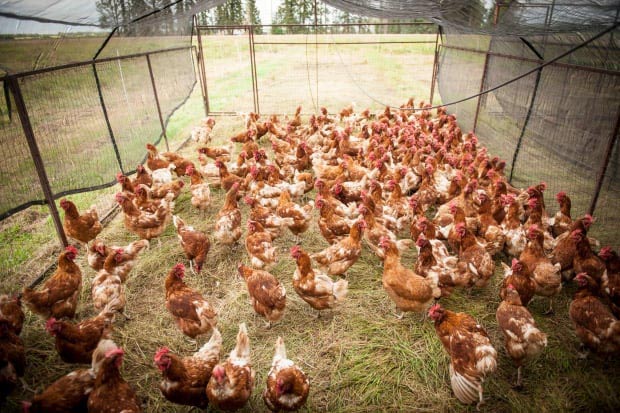
Certified Organic
If eggs are certified organic, they must come from chickens that are free-range (cage-free plus access to the outdoors), fed organic feed (no synthetic pesticides) and receive no hormones or antibiotics.
But as was the case with "free-range" eggs, "organic" eggs are usually coming from birds that live in crowded, industrial aviaries. Check out this egg scorecard that rates organic egg farms on a much wider variety of factors.
In order to qualify for USDA organic certification, the grains used for the hens’ diets must be produced on land that has been free from the use of toxic and persistent chemical pesticides and fertilizers for at least three years.
Genetically engineered crops are not permitted, and hens must be maintained without hormones, antibiotics, and other intrusive drugs.
Pasture-Raised
In terms of replicating chickens' natural environment and way of life, pasture-raised is pretty much the gold standard. Pasture-raised birds spend most of their life outdoors, with a fair amount of space plus access to a barn. Many are able to eat a diet of worms, insects and grass, along with corn feed (which may or may not be organic).
This is one of the best choices out there.
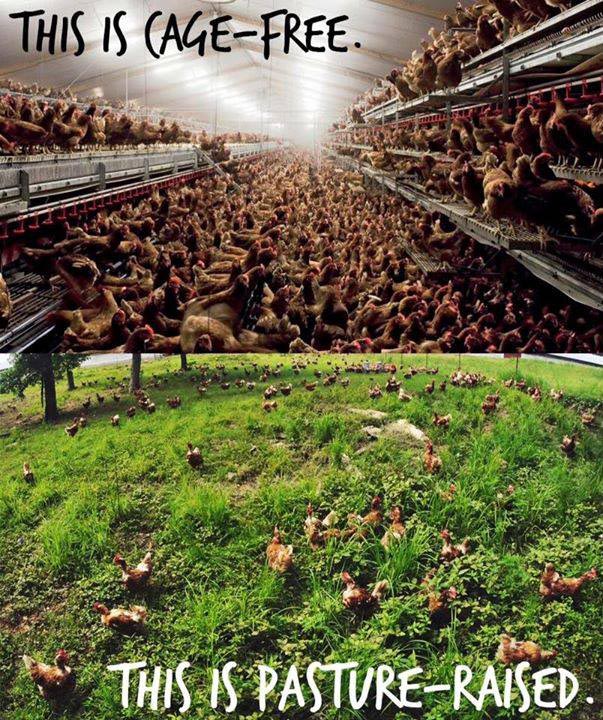
Certified Humane
Run by Humane Farm Animal Care, the Certified Humane program offers three levels of certification. All prohibit forced molting through starvation but allow beak cutting. Third-party auditing verifies compliance.
Regular (cage-free)
- Birds are uncaged inside barns but may be kept indoors all the time
- Birds must be able to nest, perch and dust-bathe
- Suppliers must follow regulations for stocking density, perch numbers and nesting boxes
Free-range
- Birds must have access to an outdoor area for at least six hours each day
- Each hen must have at least 2 square feet (288 square inches) of outdoor space
- The outdoor space doesn’t need to have any living vegetation
Pasture-raised
- Birds must be placed on a pasture for at least six hours each day
- Each hen must have at least 108 square feet (15,552 square inches) of pasture
- The pasture must be covered mainly with living vegetation
For more information on egg labels, check out this NPR article.
Meat
At 4P Foods, all of our meats are pasture-raised. This lets animals be as close to nature as possible, and live a happy life.
When you see labels such as "natural" or "humanely-raised" in stores, be aware that they aren't regulated and don't mean anything - these are just marketing buzzwords. When looking to buy meat, these 5 labels below give a much better insight into what you're eating.
Grass-fed - Found on beef, lamb, and goat products only.
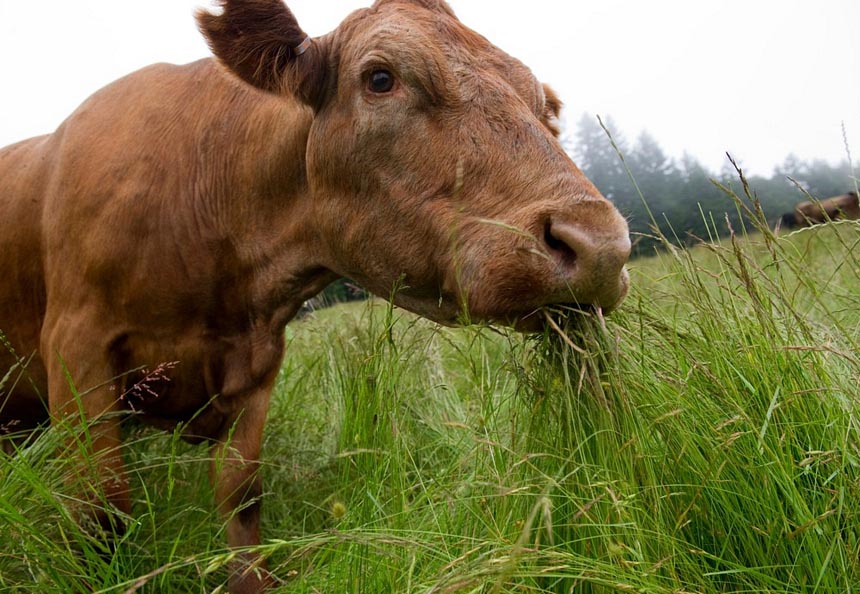
Grass-fed animals eat grass or hay for all or most of their lives, either on pasture or indoors.
Factory farmed animals eat grain for most of their lives — a food they did not evolve to eat.
Some farms and food companies call their meat grass-fed even if the animals were fed grain during the last few months or weeks of their lives (this is called grain-finishing). If you want 100% grass-fed meat, look for that 100% number on packaging, or look for the AGA or AWA grass-fed certification label.
Pasture-Raised - found on all types of meat.
Pasture-raised animals live primarily on fields or in woods, where they eat grass, plants, or shrubs.
That said, farmers might add grain to the diet of pasture-raised animals during the winter, when pastures are covered with snow and animals are brought inside. And pigs and chickens raised on pasture need at least some grain to thrive.
Free-Range - found on poultry products.
Free-range poultry are raised in barns and given access to the outdoors. How much time they actually spend outdoors, and whether the outdoor area is pasture or bare ground, varies from farm to farm.
Indoor conditions might also vary; facilities might be crowded, or lack perches or nest boxes. You can’t be sure how a farm or company defines “free-range,” so look for other certifications such as Certified Humane.
Humane Certifications - found on all types of meat.
A “humane certifier” is an organization that visits farms at least annually to make sure they’re following the organization’s detailed animal care standards. If a farm or company passes the audit, it’s officially certified and can use the organization’s label on its products.
There are four humane certifiers in the U.S.; you can look for their labels when you shop. Just keep in mind that they all have different standards, and be aware that many small-scale farmers choose not to get humane certification.
Certified Organic - found on all types of meat.
If meat is certified organic, it means that animals eat only organic feed — grains or grasses not grown with GMO seed or synthetic pesticides or fertilizers — and that they’re not given antibiotics or hormones. Whether they eat grass or grain is not specified.
All certified organic animals must have access to the outdoors, though for how long and how often is not specified. Cows, sheep, and goats must have access to pasture during the grazing season. Pigs and poultry aren’t required to have pasture, only access to an outdoor area.
Certified organic farms must ensure that living conditions allow animals to express natural behaviors, but there is no federal definition of “natural behaviors” and no exact space requirements (more on this here).
In conclusion, food labeling is incredibly confusing - much of it is just marketing or advertising that lacks meaning. We strive to help you make better consumer decisions, by buying from small family farms who care about the land and animals that they raise. In short, we guarantee that our products are the best out there for your health and the environment. We thank you for your support in continuing to build a better food system.